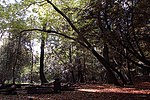Portway, Bristol

The Portway is a major road in the City of Bristol. It is part of the A4 and connects Bristol City Centre to the Avonmouth Docks and the M5 motorway via the Avon Gorge. The road was constructed following World War I in order to provide improved access to the ports at Avonmouth Docks, which had replaced Bristol Harbour as the major local centre for commercial shipping. Upon opening on 2 July 1926, it was the single most expensive road project in Britain, costing £800,000 (now about £49 million). The construction posed a number of significant engineering challenges, including long and deep rock cuttings, a viaduct over the River Trym, and retaining walls against the gorge adjacent to the River Avon. Falling rocks have since been a problem along the Portway, particularly at the southern end close to the Clifton Suspension Bridge, with concrete canopies constructed to prevent loose rock and assist with remedial work. The Portway remains an important route to and from Bristol, and is now used as part of the Portway Park and Ride scheme. In the 21st century, the road has been regularly shut to motor traffic for maintenance, providing sporting events such as the Bristol Half Marathon, or to allow locals to enjoy a traffic-free view of the Avon Gorge.
Excerpt from the Wikipedia article Portway, Bristol (License: CC BY-SA 3.0, Authors, Images).Portway, Bristol
Portway, Bristol Sneyd Park
Geographical coordinates (GPS) Address Nearby Places Show on map
Geographical coordinates (GPS)
| Latitude | Longitude |
|---|---|
| N 51.47652 ° | E -2.64882 ° |
Address
Portway
Portway
BS9 1SU Bristol, Sneyd Park
England, United Kingdom
Open on Google Maps







